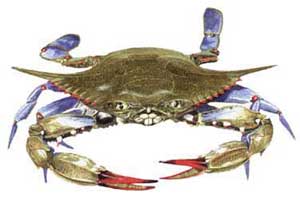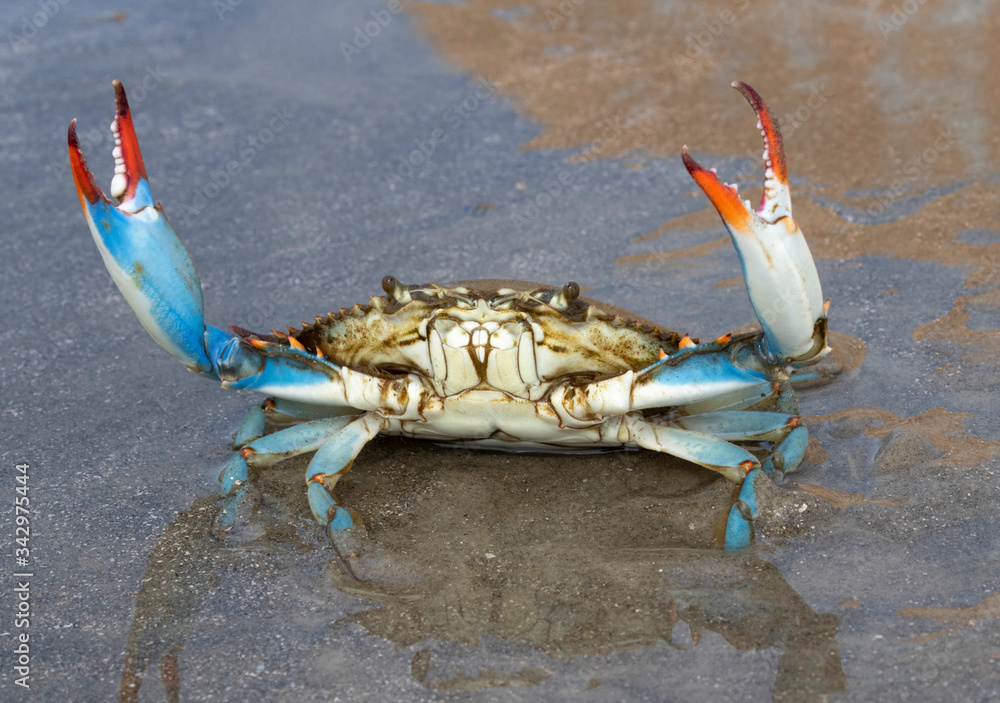The Texas Gulf Coast—a haven for so many things we hold dear, especially in the summer months. One resident of our Gulf waters that’s always a topic of conversation is the blue crab. People love to catch, cook, and eat them, and we’re here to tell you all about these wonderful creatures. In this month’s article, we’ll explore everything from the ecology of blue crabs to the rules and regulations you should be aware of. So, let’s dive in!
Exploring the Ecology of Texas Blue Crabs
Blue crabs have a unique blue-green shell that turns bright orange when cooked. The blue crab’s carapace (or shell) is about 7 inches (17.8 cm) wide and 4 inches (10.2 cm) long. It weighs 1 to 2 pounds (0.45 to 0.9 kg) when fully grown.They’re also adorned with fierce-looking but fascinating claws—one for crushing and one for cutting.

Knowing how to identify male and female blue crabs can make your crabbing more ethical and sustainable. Males generally have a T-shaped apron on their belly, while females have a rounded, more triangular one. Mature females, known as “sooks,” have red-tipped claws. It’s like they’re wearing nail polish.
These versatile crustaceans inhabit various niches, from brackish estuaries to the salty open waters of the Gulf of Mexico. Blue crabs are most commonly found in shallow waters with plenty of hiding spots like grass beds and submerged structures. However, these crabs have a rather complicated life. After hatching, they go through several larval stages in open waters before settling in estuaries. They molt—shed their shells—to grow, going through a soft-shell stage that’s a delicacy for many seafood lovers. As they mature, their migratory patterns change, often venturing to deeper waters.
Insider Tip: Late spring and early fall are excellent times to crab because it’s when mature blue crabs are most abundant in shallower waters.
The Impact of Blue Crabs in Texas
In nature, everything is interconnected, and blue crabs are no exception. They serve as both predators and prey within the Gulf Coast’s intricate food web. As predators, they feed on a variety of organisms, including smaller fish, plankton, and detritus, helping to keep these populations in check. As prey, they serve as a critical food source for many species, like red drum, larger fish, and even some birds. By being both the diner and the dinner, blue crabs help maintain a balanced and healthy ecosystem.
The population of blue crabs has historically experienced fluctuations due to various factors. Overfishing and habitat degradation, particularly the loss of wetlands and marsh areas, can have a negative impact on crab numbers.
But not to worry, these guys aren’t going anywhere as the Gulf has an over abundance of these crabs and their friends.
An Economic Powerhouse for the Texas Gulf
Blue crabs aren’t just valuable in an ecological sense; they also contribute significantly to the Texas economy. The commercial crabbing industry is a major revenue generator, providing jobs and livelihoods to many Texans along the Gulf Coast. From fishermen to restaurant owners, a healthy blue crab population translates to a healthier economy.
Industry Fact: Texas is one of the top states in blue crab production, with the industry generating millions of dollars annually.
A Culinary Icon
And because of those numbers, blue crabs hold a special place in the heart of Texas culinary traditions. From crab boils to sumptuous crab cakes, this delectable seafood graces our tables in many forms. It’s not just food; it’s a cultural experience that brings families and communities together.
If you find yourself with some blue crabs in your net (or grocery cart) here are some recipes you can try:
- Steamed Crabs: https://www.allrecipes.com/recipe/178366/steamed-blue-crabs/
- Southern Blue Crab Cakes: https://www.gritsandpinecones.com/easy-southern-style-blue-crab-cakes/
The importance of blue crabs in Texas stretches far beyond their culinary appeal. They play an essential role in maintaining the health of our local ecosystems, provide economic stability to coastal communities, and enrich our cultural traditions. It’s no exaggeration to say that the blue crab is an integral part of what makes the Texas Gulf Coast so unique and valuable.
Responsible Crabbing & How to Catch Them
Before you get your crab nets ready, it’s important to understand the rules. There are no bag limits, but there is a 5-inch minimum body width as measured from spine to spine. Keeping “sponge” crabs – female crabs with spongy masses of eggs on their abdomens – is also illegal.
Crabbing doesn’t require much—a simple crab net and some bait like chicken necks can get you started. Places like Galveston Bay or Matagorda Bay are popular spots. Dawn and dusk are often the best times to go crabbing, especially during late spring to early fall.
Video: How to catch a Blue Crab
Blue crabs are more than just a summer pastime; they’re a vital part of our Texas Gulf Coast culture, ecosystem and economy. Happy crabbing!









